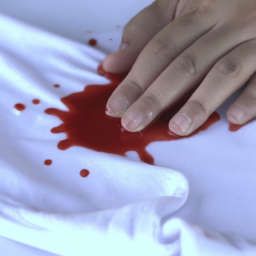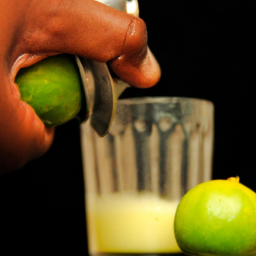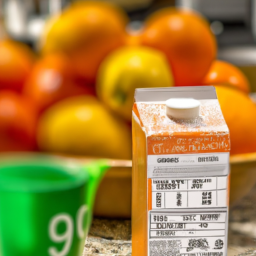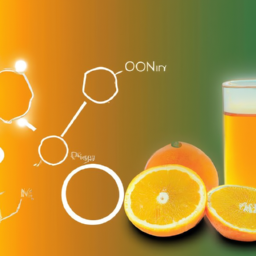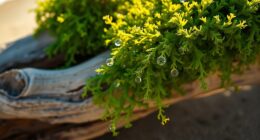As someone who enjoys a refreshing glass of cranberry juice, I understand the struggle of removing those pesky stains from my clothes. It’s almost as challenging as removing a red wine stain – it can seem like a daunting task. But fear not, with the right techniques and a little elbow grease, it is possible to successfully remove cranberry juice stains from your clothing.
Picture this: you’re at a holiday party and someone accidentally spills cranberry juice on your favorite shirt. You try to wipe it off with a napkin, but the stain just won’t budge. You start to panic, thinking you’ll have to throw the shirt away or resign it to ‘stain only’ status.
But don’t give up hope just yet – there are ways to remove cranberry juice stains and save your clothes from being ruined. In this article, I’ll share some tried and true methods for getting rid of those pesky stains and getting your clothes back to their pre-stain glory.
Key Takeaways
- Act quickly to prevent the stain from setting in.
- Use a stain remover specifically for fruit stains or with enzymes.
- Soak the stained fabric in cold water for at least 30 minutes.
- Baking soda is an eco-friendly and affordable option.
Act Quickly to Prevent Set-In Stains
You gotta act fast if you wanna stop that cranberry juice stain from setting in! Preventive measures are key in ensuring that the stain doesn’t become too stubborn to remove.
As soon as the juice spills on your clothes, grab a clean cloth or paper towel and blot the area gently. Don’t rub the stain, as this could push it deeper into the fabric.
Once you’ve removed as much of the juice as possible, it’s time to move on to effective stain removal techniques. Start by running cold water over the stain, holding the fabric under the tap with the wrong side facing up. This will help to flush out any remaining juice before it has a chance to set in.
Blot the Stain with Cold Water
First, try dabbing the affected area with icy water to prevent the stain from setting. This is a crucial step in removing cranberry juice stains effectively. Cold water works wonders when it comes to lifting stains, and it’s especially helpful in dealing with acidic stains, like cranberry juice.
Here’s why cold water is important in stain removal:
- It helps prevent the stain from setting into the fabric.
- It helps to dilute the stain, making it easier to remove.
- It’s a safe and effective method for removing stains without damaging the fabric.
Different types of stains require different methods of treatment. However, cold water is always a great first step to take when dealing with any type of stain.
After you’ve blotted the stain with cold water, the next step is to use a stain remover to completely get rid of the cranberry juice stain.
Use a Stain Remover
Now it’s time to grab a stain remover and tackle that stubborn mark on your garment! When it comes to cranberry juice stains, there are several types of stain removers that can effectively remove the mark. Look for a stain remover that specifically targets fruit stains or one that contains enzymes to break down the proteins in the juice.
Before using the stain remover, it’s important to take some precautions. First, check the label of your garment to ensure that the stain remover is safe to use on the fabric. Then, test the stain remover on a small, inconspicuous area of the garment to make sure that it doesn’t cause any damage or discoloration.
Once you’ve determined that it’s safe to use, apply the stain remover directly to the stain and let it sit for the recommended amount of time before washing the garment as usual. With the right stain remover and proper precautions, you can say goodbye to that pesky cranberry juice stain.
Now that you’ve treated the stain with a remover, the next step is to soak the stained fabric in cold water.
Soak the Stained Fabric
To effectively remove stubborn cranberry juice stains from clothes, soaking the stained fabric in cold water is a crucial step that can increase the chances of successful stain removal by up to 50%. However, there are some precautions to keep in mind while soaking to ensure that the fabric doesn’t get damaged.
Firstly, make sure to use cold water as hot water can set the stain further and make it harder to remove. Secondly, avoid using bleach or any other harsh chemicals while soaking as it can damage the fabric.
To maximize effectiveness, soak the stained fabric for at least 30 minutes. For tougher stains, you can even leave it overnight. Once the soaking is done, gently rinse the fabric with cold water before proceeding to wash it.
Now that the stained fabric has been soaked, it’s time to wash it. But before washing, make sure to check if the stain has been completely removed. If not, repeat the soaking process until the stain is removed.
Once the stain is removed, wash the fabric as you normally would. By following these steps, you can effectively remove cranberry juice stains from clothes without damaging the fabric.
Wash the Fabric
Now that I’ve soaked the stained fabric, it’s time to wash it. There are two ways to do this: hand washing or machine washing. Hand washing is a more gentle option that allows for more control over the process, while machine washing is quicker and more convenient.
I’ll discuss the pros and cons of each method to help you decide which one is best for your situation.
Hand Washing
If you’re washing your clothes by hand, be sure to use cold water and a gentle detergent to avoid damaging the fabric. Hand washing has its benefits, especially for delicate fabrics like silk or wool.
You have more control over the washing process, and you can avoid using harsh chemicals or high heat that can damage the fibers. When hand washing, it’s important to be gentle with the fabric. Avoid scrubbing too hard or twisting the fabric, as this can cause stretching or tearing.
Instead, gently agitate the fabric in the water and let it soak for a few minutes before rinsing thoroughly. By taking the time to hand wash your clothes, you can ensure that they stay in good condition and avoid the risk of damaging them in a machine wash.
Speaking of which, if you prefer to use a washing machine, let’s move on to the next step.
Machine Washing
Using a washing machine is like entrusting your clothes to a powerful whirlwind that can clean and rinse them thoroughly, but also has the potential to damage them if not used properly. While hand washing is a gentle way to remove cranberry juice stains, machine washing offers several benefits that make it a more efficient and convenient option.
Benefits of machine washing vs hand washing:
- Saves time and energy
- Can handle larger loads of laundry
- Provides a more thorough cleaning
- Allows for the use of hot water and detergent to effectively remove stains
To maintain washing machine efficiency, it’s important to follow these tips:
- Clean the machine regularly to prevent buildup of detergent and fabric softener residue
- Use the appropriate amount of detergent and avoid overloading the machine
- Check the pockets of clothing for loose items that could damage the machine during the wash cycle
Incorporating these tips into your machine washing routine will ensure that your clothes are cleaned effectively without causing any damage to the machine. Use bleach (if safe for the fabric) to remove any remaining cranberry juice stains from your clothes.
Use Bleach (If Safe for the Fabric)
Bleach can be a lifesaver for stubborn cranberry juice stains, but it’s important to consider whether it’s safe for the fabric before using it. Some fabrics, like silk or wool, can be damaged by bleach. If that’s the case, there are safe alternatives to remove stains.
If the fabric can handle bleach, mix one part bleach with four parts water and soak the stained area for 15 minutes. Rinse thoroughly with water and wash the garment as usual. Follow the instructions on the bleach bottle and avoid leaving it on for too long, as it may cause discoloration or damage to the fabric.
If bleach isn’t an option, try vinegar or lemon juice as natural alternatives to remove cranberry juice stains.
Try Vinegar or Lemon Juice
For a natural alternative to bleach, give vinegar or lemon juice a shot – they work like a charm in removing those stubborn cranberry juice stains from your favorite garments. These acidic solutions are safe for most fabrics and can be found in almost any household.
To use, simply mix equal parts water and vinegar or lemon juice and apply the solution onto the affected area. Let it sit for about 10-15 minutes before rinsing with cold water. Repeat the process until the stain is completely gone. Alternatively, you can soak the garment in a mixture of water and vinegar or lemon juice for a few hours before washing as usual.
Transitioning into the subsequent section, another effective method for removing cranberry juice stains is to use baking soda.
Use Baking Soda
Baking soda is a versatile household item that can help eliminate pesky discolorations on your favorite fabrics. It’s not only great for baking cakes and cookies, but it also offers amazing benefits for removing stains from clothes.
Here are some baking soda benefits when it comes to removing cranberry juice stains:
-
Baking soda can act as a natural bleaching agent that can remove the discoloration caused by cranberry juice stains.
-
It can also help to neutralize the acidic pH of the juice, which makes it easier to remove the stain without damaging the fabric.
-
Baking soda can be mixed with water to form a paste that can be applied directly to the stain, allowing it to penetrate deep into the fabric fibers.
-
Lastly, baking soda is a more affordable and eco-friendly option compared to harsh chemicals that may not be suitable for all types of fabrics.
While baking soda is an effective remedy for removing cranberry juice stains, it’s important to test the fabric before using harsh chemicals. This will ensure that the fabric doesn’t get damaged or discolored in the process.
Test the Fabric Before Using Harsh Chemicals
Now, before you go ahead and use baking soda on your cranberry juice stained clothes, it’s important to test the fabric first. Fabric sensitivity can vary greatly, and using harsh chemicals without knowing how the fabric will react could lead to irreversible damage. This is why it’s important to always test a small, inconspicuous area of the garment before proceeding with any cleaning methods.
To do this, simply apply a small amount of the cleaning solution you intend to use on a hidden area of the garment. Wait a few minutes, then check for any discoloration or damage to the fabric. If everything looks good, then you can proceed with treating the cranberry juice stain. If not, then it’s best to try a different cleaning method or take the garment to a professional cleaner.
In addition to testing the fabric, there are also pre-treatment options you can consider before using harsh chemicals. For example, you can try soaking the stained area in cold water for a few hours before attempting to remove the stain. This can help to loosen the stain and make it easier to lift out. Alternatively, you can try applying a small amount of white vinegar or lemon juice to the stain before washing. Both of these options can help to break down the stain and make it easier to remove. By taking these steps to test the fabric and consider pre-treatment options, you can increase your chances of successfully removing cranberry juice stains from your clothes without causing any damage.
Frequently Asked Questions
Can cranberry juice stains be removed from all types of fabrics?
Yes, cranberry juice stains can be removed from most fabrics. However, the compatibility of alternative stain removal techniques may vary depending on the type of fabric. It’s important to test on a small, inconspicuous area first.
How long should the stained fabric soak before washing it?
Before washing stained fabric, I recommend pre-treatment tips such as soaking in vinegar and water. Best washing techniques include using cold water and a heavy-duty detergent. Time-wise, let it soak for at least 30 minutes.
Will using bleach on a cranberry juice stain damage the fabric?
Using bleach on cranberry juice stain may damage the fabric, as it can weaken the fibers and cause discoloration. Instead, I suggest using vinegar as an alternative. It is effective in removing stains and safe for most fabrics.
Can the same method be used to remove dried cranberry juice stains?
Removing dried cranberry juice stains requires alternative methods and precautions. I suggest using vinegar and baking soda to break down the stain. However, test on a small area first to avoid further damage.
Is it safe to mix different stain removal solutions together?
Mixing solutions can be dangerous and should be avoided. Different chemicals can react and cause harmful fumes or even explosions. Always read labels and follow safety precautions when using stain removal solutions.
Conclusion
Well, that’s how I got rid of cranberry juice stains from my clothes. It’s a frustrating experience to see a stain on your favorite outfit, but with a little care and attention, you can remove it easily.
Remember to act quickly, use cold water to blot the stain, and then apply a stain remover. Soak the fabric and wash it. If the fabric can handle it, use bleach, vinegar, or lemon juice. And don’t forget baking soda!
In conclusion, accidents happen, but they don’t have to ruin your clothes forever. With the right tools and techniques, you can remove even the toughest stains.
So next time you spill cranberry juice on your shirt, don’t panic. Follow these steps and enjoy a stain-free wardrobe. After all, who wants to be walking around with a big red stain on their shirt all day? Not me!
Ilana has been a vegan for over 10 years. She originally made the switch for health reasons, but soon found herself becoming more and more passionate about the ethical and environmental implications of a vegan lifestyle. Ilana is the author of The Graceful Kitchen, a blog all about veganism. She loves to cook up delicious and nutritious vegan meals, and share her recipes with others who are interested in leading a cruelty-free life. Ilana is also a strong advocate for using whole foods as the foundation of a healthy diet, and believes that going vegan is one of the best ways to achieve this.
